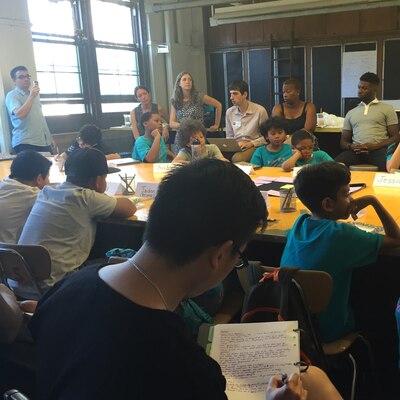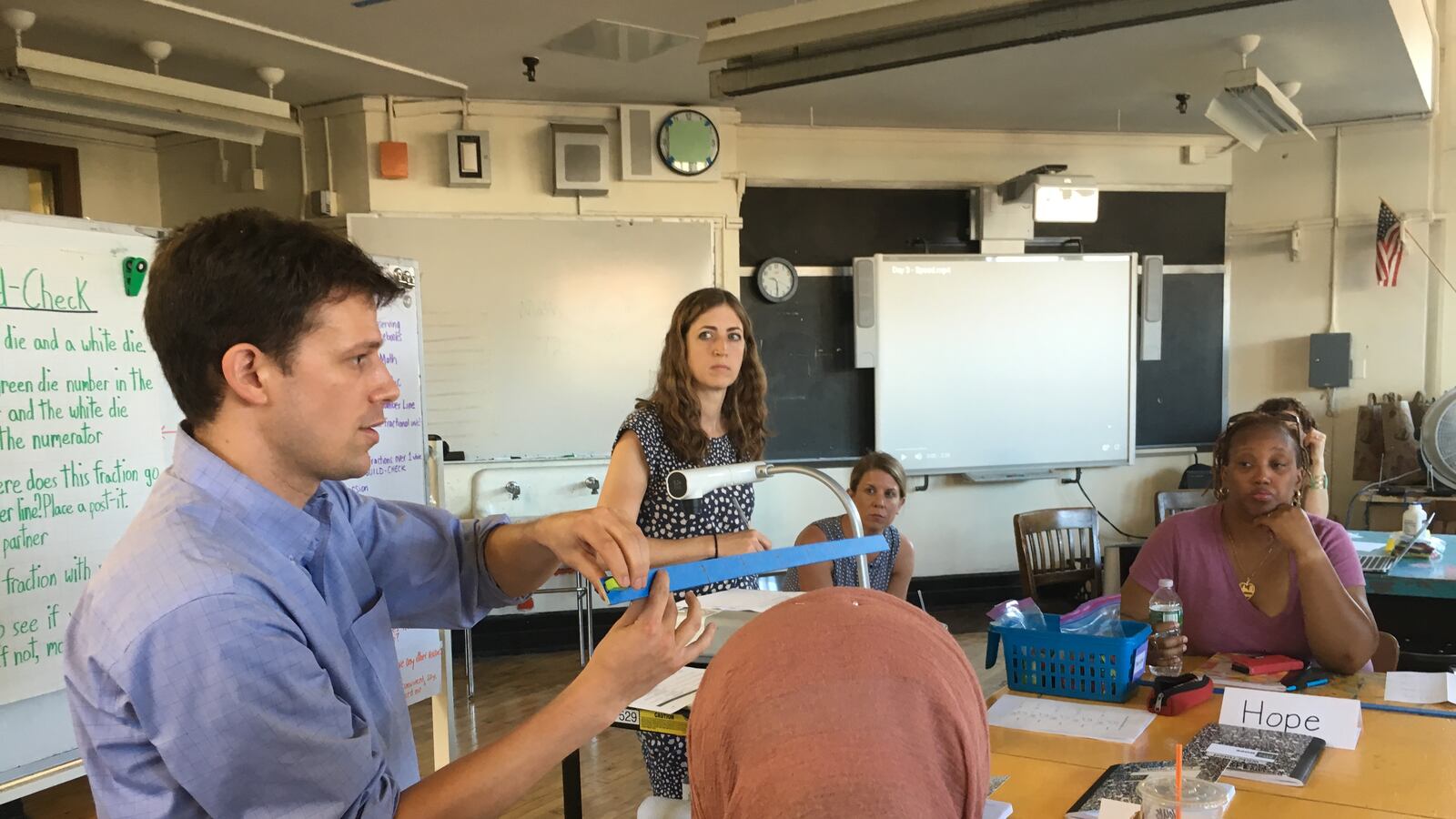Earlier this week, Peter Cipparone was ending a meticulously planned lesson when the student he’d called to the board suddenly slipped. Kris, a rising fifth grader, was, Cipparone later said, a “plant” — selected because Cipparone felt confident he could clearly explain the fractions problem at hand to the rest of the class.
But when Kris got to the board, his understanding seemed to vanish. He was supposed to be placing the fraction five-thirds on a number line, but instead he marked off five and one-third, almost four points too far.
With just a few minutes left in class, held at the High School for Fashion Industries in Manhattan, Cipparone had to make a split-second decision: Should he offer the correct answer, or let students leave for the day without a clear resolution?
It was a tough call, but Cipparone knew he had backup. Unlike a traditional lesson, where educators teach in isolation, in this case, Cipparone was surrounded by 21 other teachers who would pore over every element of his teaching once the class ended.
The lesson is part of a New York City program, now in its second year, that is tasked with teaching two groups of people simultaneously: A group of rising fifth-graders like Kris, who spend two hours each day learning about fractions — and a group of educators from across the city who have signed up to improve their own teaching.
The program, known as the New York City Math Lab, gives educators an opportunity to perform the surprisingly rare work of watching each other teach. It also lets them hone an approach encouraged by the Common Core learning standards that many of the participating teachers said they have struggled to perfect: Getting students to learn math not just by practicing problems, but also by having conversations.
“With rules-based teaching, if you don’t understand why you’re doing what you’re doing, then that rule only applies to that very specific type of problem,” explains Kim Van Duzer, a teacher at Brooklyn’s P.S. 29 who co-founded the lab program along with Cipparone and Kate Abell, who have both taught in New York City schools. “If you have an underlying understanding of operations and the number system, you can build on that to answer other sorts of questions — that’s what reasoning is.”
***
For a week during the summer, Van Duzer, Cipparone and Abell host roughly 25 educators with a range of teaching experience who watch the trio perform a sequence of lessons on fractions, sitting on the sidelines of a large classroom as the class works. Then, when the students leave, returning to a summer program offered by the Hudson Guild, the teachers talk about what they saw.
The Math Lab’s emphasis on learning math by talking and thinking about it is clear almost as soon as the students enter the room. A list of the class’ “math community agreements,” posted on a board, reminds students to “add onto each other’s thinking” and “analyze and observe each other’s work.”

To help students internalize that philosophy, Van Duzer led an activity called “convincing a skeptic,” where students were asked to fold pieces of green paper into squares one quarter the size of the original and then convince their partner that the new shape was, in fact, one-fourth of the original.
Some students struggled to articulate why the squares they folded were one-fourth of the whole piece of paper. “Sometimes my partner asked questions I didn’t understand,” one student admitted. But encouraging students to challenge each other’s ideas paid off later that morning.
After introducing the idea of representing fractions on a number line, Cipparone asked students to begin thinking about whether eight-sixths is greater than one. Nine and 10-year-old skeptical voices quickly emerged.
One student declared that eight-sixths is less than one, only to be told by someone sitting nearby that he had the numerator and denominator confused. The ensuing debate ended when the first student admitted his mistake and leapt at the chance to offer a correct answer in his own words.
Many of the teacher observers said the lab was the first time they were able to watch another educator teach consecutive lessons. Watching others teach, they said, helped them become more confident in their own ability to guide students through conversations about fractions.
“You can read a [lesson] plan, but they do so much more that’s not in the plan — how to elicit students’ thinking, or how to get them to respond to each other,” said Julie Heller, a teacher at Brooklyn’s P.S. 29, where Van Duzer also teaches.
Laura Burns, a 20-year veteran teacher from P.S. 73 who also attended last year’s lab, said the experience gave her ideas about how to tweak her instruction, including posting a schedule outlining the elements of the day’s lesson so students have a sense of where they are headed.
“I can just watch and see everything – the language, the materials, the way they’ve laid stuff out. They’ve agonized over every decision,” she said.
***
As teachers reflected on Tuesday’s lesson, a debate of their own emerged. They began wondering about how Cipparone handled what the group would begin calling “Kris’ problem” — the moment that morning when Kris misplaced five-thirds on the number line and Cipparone had to make a split-second decision about whether to correct him before the students left for the day.
Deirdre Flood, a teacher at Brooklyn’s P.S. 11, said it could make sense to end the lesson ambiguously if “every single [student] made a decision before they left, so they were thinking about it on their way out.”
Another teacher wondered whether withholding the correct answer might leave Kris feeling tricked when he inevitably discovered his answer had been wrong all along. Meanwhile, Abell, one of the Math Lab’s facilitators, suggested a different approach altogether.
“It feels like a terrible thing to not let him finish his idea,” she said. “The question for the community is, ‘What is Kris thinking?’ Because he’s thinking something that makes sense.” Instead of debating whether to correct him or not, she argued, teachers should encourage other students to explain why he came to equate five-thirds for five and a third — because he mistakenly considered five as the whole, rather than the number of parts.
For his part, Cipparone never pointed out Kris’ error that morning. He threw the question back to the class for a quick debate. And even though some students argued their classmate was wrong, Cipparone stood back and facilitated.
“Sometimes you have questions and you don’t get the answers all at once,” he said, just moments before students filed out. “If you’re not convinced, that’s OK!”

